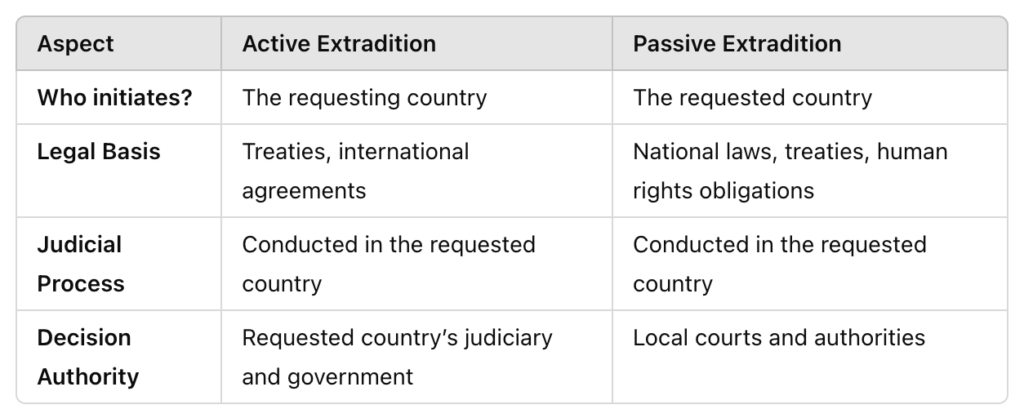Extradition is a crucial legal mechanism that facilitates international cooperation in criminal matters. It ensures that individuals accused or convicted of crimes do not evade justice by crossing borders. However, extradition can be classified into two main types: active extradition and passive extradition. Understanding the distinctions between these procedures is essential for legal professionals handling cross-border legal cases.
Active Extradition: Requesting a Person from a Foreign Country
Active extradition occurs when a State requests the extradition of an individual from a foreign country. This process typically involves:
- Issuing an Extradition Request: The requesting State submits a formal legal request, outlining the charges and the legal basis for extradition.
- Diplomatic and Judicial Review: The authorities of the requested country evaluate the request based on bilateral or multilateral treaties.
- Court Proceedings: The person sought may challenge the extradition in the courts of the requested State.
- Decision and Transfer: If approved, the individual is handed over to the requesting country to stand trial or serve a sentence.
Active extradition is often employed in cases involving serious crimes, such as terrorism, drug trafficking, and financial crimes.
Passive Extradition: Responding to an Extradition Request
Passive extradition is the opposite process, where a country receives an extradition request and evaluates whether to surrender the requested individual. The key steps include:
- Receipt of the Request: The requested country receives an extradition request from the requesting State.
- Judicial Examination: The local judiciary examines whether the request meets legal requirements, including double criminality (i.e., the act must be a crime in both jurisdictions).
- Human Rights Considerations: The requested country assesses human rights concerns, such as the risk of torture, unfair trial, or political persecution.
- Decision and Execution: If the request is granted, the individual is transferred to the requesting country.
Passive extradition is subject to stricter legal safeguards, ensuring that fundamental rights are protected throughout the process.
Key Differences Between Active and Passive Extradition

Legal Framework and Challenges
The extradition process is governed by international treaties, including the European Convention on Extradition and bilateral agreements between nations. However, challenges often arise, including:
- Conflicts in legal systems (e.g., differing definitions of crimes)
- Political interference, where countries refuse extradition for political reasons
- Human rights concerns, where extradition may lead to unfair treatment or inhumane conditions
For legal professionals, navigating these complexities requires expertise in international law and diplomatic relations.
Conclusion: A Vital Tool for International Justice
Both active and passive extradition play an essential role in combating transnational crime and ensuring justice. While active extradition is the process of requesting extradition from another country, passive extradition involves responding to such requests within a legal framework. Legal professionals must carefully assess each case, considering both legal and human rights implications.
By understanding these distinctions, lawyers can better advise their clients and navigate the complexities of extradition law.

